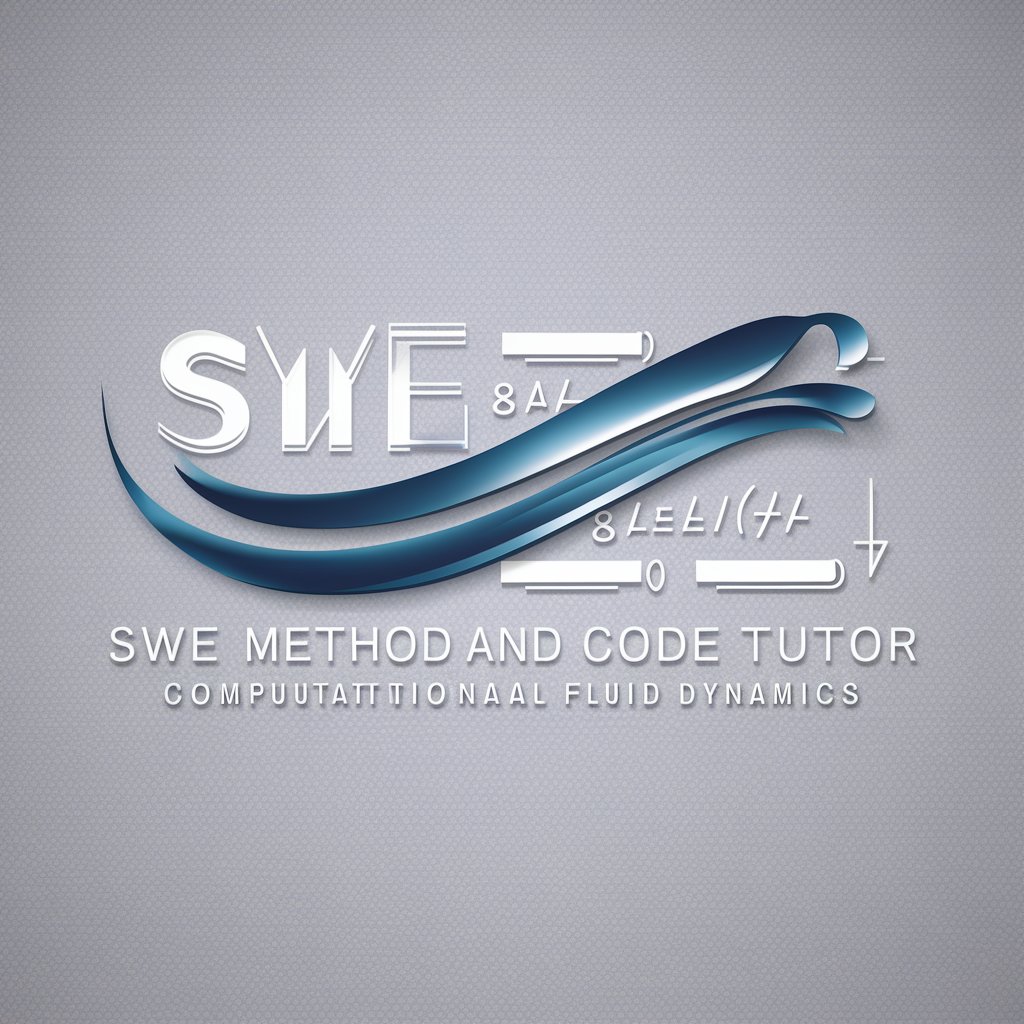SWE Method and Code Tutor - Fluid Dynamics Simulator

Welcome to SWE Method and Code Tutor!
AI-driven fluid dynamics education and simulation
Explain the role of source terms in the shallow water equations.
How does the Godunov-type method apply to the shallow water equations?
Describe the Surface Gradient Method for solving fluid dynamics problems.
What are the key advantages of the Finite Volume Method in fluid dynamics?
Get Embed Code
Introduction to SWE Method and Code Tutor
SWE Method and Code Tutor is a specialized tool designed to teach and explain the shallow water equations (SWE) used in fluid dynamics and simulation. Its core purpose is to provide a comprehensive understanding of the mathematical models and numerical methods for simulating fluid dynamics in shallow water environments. This includes rivers, lakes, and coastal areas where water depth is significantly less than its horizontal dimension. An example of its application is aiding in the development of simulations for flood forecasting and water resource management, where it can explain the impact of various physical and numerical parameters on the simulation outcomes. Powered by ChatGPT-4o。

Main Functions of SWE Method and Code Tutor
Teaching Fluid Dynamics Concepts
Example
Explains fundamental principles such as hydrostatic balance and momentum conservation in the context of shallow water.
Scenario
Used in academic settings or research institutions to enhance the learning curve of students and new researchers.
Simulating Water Flow Dynamics
Example
Runs simulations to show how changes in riverbed topography affect water flow, helping in planning flood defenses.
Scenario
Utilized by civil engineers and hydrologists to model potential changes in water systems due to natural or man-made alterations.
Interactive Problem Solving
Example
Offers interactive modules that allow users to input specific conditions like dam breaks, and observes the resulting water dynamics.
Scenario
Helpful for emergency management teams to train on and predict flood scenarios in real-time.
Ideal Users of SWE Method and Code Tutor
Academic Students and Researchers
These users benefit from the educational aspects of the tool, using it to understand complex fluid dynamics theories and apply them in practical scenarios.
Professional Engineers and Hydrologists
Professionals use the tool to simulate and predict water behavior in various infrastructures and natural settings, aiding in effective planning and risk management.

Guidelines for Using SWE Method and Code Tutor
Step 1
Visit yeschat.ai for a free trial without login, and no need for ChatGPT Plus.
Step 2
Select the 'SWE Method and Code Tutor' from the available tools to start your session.
Step 3
Input your specific fluid dynamics problem or query related to the shallow water equations to receive guidance or code examples.
Step 4
Use the interactive features to modify the provided examples and see real-time results, enhancing understanding through practical application.
Step 5
For complex queries, use the detailed documentation and examples provided within the tool to deepen your understanding and assist in problem-solving.
Try other advanced and practical GPTs
Shallow Beauty Matcher
Real Connections, AI-Enhanced

ShallowL Translator
Transform Text Seamlessly - Powered by AI

Monolith Studios' Business & Design Guide
Empowering Design with AI Insight

Ancient Monolith Explorer
Unveil History with AI

Monolith
Learn Languages, AI-Enhanced

Research Paper Reviewer
Empowering Your Research with AI

English Mentor
AI-powered English Learning Simplified

human rewriter DE
Elevate Your Texts with AI-Powered Rewriting

Peter
Empower Your Words with AI

Quantum Perplexity Debate
Empowering In-depth Analysis with AI Integration

Perplexity AI Oracle
Empowering decisions with AI-driven insights

Perplexity GPT
Empowering Inquiry with AI

Frequently Asked Questions about SWE Method and Code Tutor
What is the SWE Method and Code Tutor?
SWE Method and Code Tutor is an AI-based tool designed to assist users in understanding and applying the shallow water equations in fluid dynamics. It offers interactive coding environments, simulations, and comprehensive explanations to help users tackle both theoretical and practical aspects of fluid dynamics problems.
How can I simulate a tidal flow using the SWE Method and Code Tutor?
To simulate a tidal flow, input the specific parameters of your tidal system into the tool. You can then utilize the coding environment to set up and run simulations, adjusting variables like wave height, velocity, and topography to observe different outcomes and understand the dynamics involved.
Can SWE Method and Code Tutor help with academic research?
Yes, the tool is particularly useful for academic research in fluid dynamics, offering capabilities to model and simulate complex fluid movements under various conditions. Researchers can use it to generate data for analysis, test hypotheses, or verify theoretical models with practical simulations.
Is there a way to visualize the results from the SWE Method and Code Tutor?
Absolutely, the tool includes visualization capabilities that allow users to graphically represent the results of their simulations. This feature is crucial for understanding fluid dynamics behavior and presenting findings in a digestible format.
What are the limitations of using SWE Method and Code Tutor?
While highly effective for educational and research purposes, the tool's simulations are simplified models of reality and may not capture every nuance of natural fluid dynamics. Users should supplement tool findings with real-world data and additional simulations where necessary.
